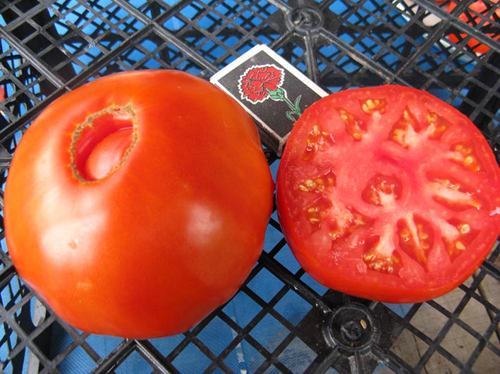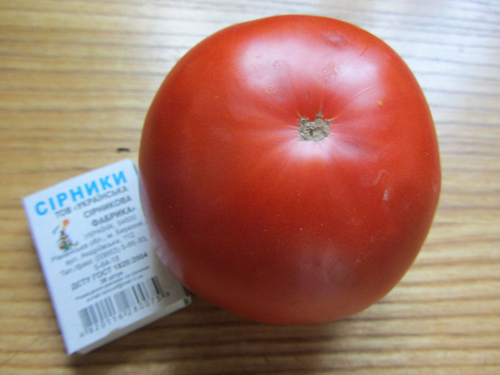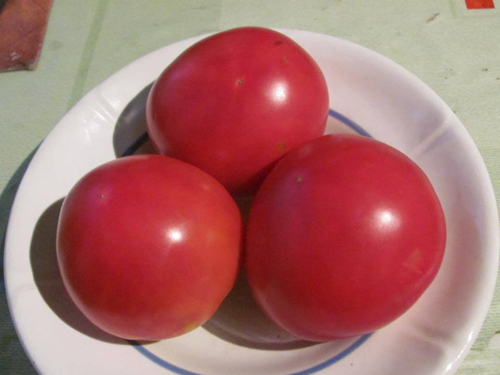Tomato variety Bovine forehead
Well, what vegetable grower would deny himself the pleasure of growing a large-fruited tomato. The question is rhetorical, because the answer is obvious. There is no gardener who, at least once, even as an experiment, would not have planted such a crop on his site. And for those who have just begun to select large-fruited and not problematic varieties, we will tell you about the next, already empirically tested variety - Bull's forehead. Its creators - V.N. Dederko, O. V. Postinikova, A. A. Yabrov. Applicant and originator - amateur breeder V.N. Dederko. In 2005, the novelty was entered into the State Register of Breeding Achievements of Russia and received admission in all regions. Recommended for growing in open ground garden plots, home gardens and small farms. In cool regions, the best performance is observed under film shelters. The tomato is not a hybrid.

Description
The plant is determinate, 1.0 - 1.5 meters high. The stem is strong, the shoot formation and leafiness are moderate. The root system is powerful. The leaves are large, green, slightly corrugated, of the usual type. The inflorescences of the Bovine forehead are simple. The first fruit cluster is laid over the 9th leaf, the subsequent ones are formed through 1 - 2 leaves, without gaps. Up to 7 ovaries can form in one brush. More than 4 brushes are formed on the central stem. The stem of a tomato is articulated.
The fruits of the variety are large, thick-walled, smooth, cuboid, but sometimes some sources describe a flat-round shape. The skin is not too thick, it separates well from the pulp. Unripe tomato is light green, with a dark spot at the stalk. When it reaches the stage of consumer ripeness, it turns red. The flesh of the Bovine forehead is very fleshy, quite dense, tender, juicy, veins are practically absent. There are 4 or more seed nests. In fact, the section shows numerous chambers, but they are very small. The taste is balanced, sweet and sour. Fresh tomatoes have excellent taste. The weight of the fetus according to the State Register is from 141 to 480 grams. With the correct rationing of the fruit cluster, the weight of individual specimens can reach 600, and even 800 grams. Also, gardeners note that the largest tomatoes are poured in the middle brushes, while in the lower and upper the weight of the fruits is not so large.

Variety characteristics
- In terms of ripening, the Bovine forehead belongs to the mid-season. From the moment of emergence of full shoots until the beginning of harvest, it takes from 111 to 115 days. In cool regions, this process may take longer, so vegetable growers prefer to grow our hero in film greenhouses;
- the fruiting period under normal climatic conditions lasts from July to September;
- gardeners note that the variety is generous in harvest. According to the State Register, the yield of marketable fruits from 1 square meter is 18.0 kg. According to other sources, with proper agricultural technology, up to 5.0 kg are removed from one plant;
- but the yield of mature marketable fruits is low - only 51% (data for the Novosibirsk region);
- the plant perfectly adapts to various weather conditions. The bovine forehead is called the record holder for setting tomatoes in unfavorable climatic conditions. The State Register noted the excellent heat resistance of the variety. This means that in hot regions, for example, in the Crimea or Krasnodar Territory, the culture will not reduce productivity due to lack of moisture and high temperatures;
- in a rainy period, when the soil is waterlogged, large fruits easily crack. Therefore, in greenhouses it is necessary to maintain normal humidity;
- despite belonging to varietal crops, our hero, according to numerous reviews, has a complex resistance to diseases. True, there is no information on this in the State Register;

- the level of transportability of the fruits of the Bovine forehead is low. Large tomatoes crumple easily and may suffer from mechanical damage. Keeping quality also cannot be called a hallmark of this species.Therefore, the harvested crop is best eaten or processed immediately;
- the purpose of the variety is universal. Fleshy tomatoes are used in their natural form, primarily for salads, processed into wonderful tomato products - pasta, juice, mashed potatoes. Some housewives use chopped large fruits for canning - a fairly dense pulp is able to retain its shape after heat treatment.
Agrotechnics
Like most varieties, Bovine forehead is best grown in seedlings. For seedlings, tomato seeds are sown in early or mid-March. The pick is carried out in the phase of two true leaves. Young plants are hardened 2 weeks before planting. Plants that are 60 - 65 days old are ready for transplantation. It is recommended not to compact the planting too much and plant no more than 4 bushes per 1 square meter. In open ground, seedlings are planted as soon as the threat of return frosts has passed - in late May or early June, in greenhouses or under film shelters earlier - in early May. Given the height of the bush and the massiveness of the fruit brushes, the plant must be tied to a support. To achieve maximum performance, it is customary to form a variety in 2 stems. Sometimes, with such a formation, the total number of inflorescences can reach 10, but it is advisable to leave no more than 7 so that the emerging ovaries have time to ripen. Grasshopping is mandatory, because there are often cases when a plant independently forms 1 or 2 more stems. In this case, there is no need to wait for large tomatoes. Timely watering and top dressing is the basis for stable tomato fruiting. The soil in the garden should be kept clean. Prevention of diseases and pests is a must.
The bovine forehead is a well-deserved success among vegetable growers. It is appreciated for its ability to cultivate even in unfavorable regions. The plant is hardworking, but it must be supported, observing agricultural techniques and performing tying and proper formation of the bush. There are no particular difficulties with leaving, therefore anyone can grow a large-fruited handsome man. But the nuances in care, of course, exist - the culture does not like waterlogging and needs prevention of diseases (especially from late blight) and pests. To speed up ripening in cooler regions, plant the variety in the sunniest area, and remove the leaves under the already formed lower brushes to redirect nutrients to the ovary. A generous harvest and long-term fruiting will allow you to replenish the body's vitamin reserves and prepare useful preservation for the winter. You can always collect seed by yourself. To do this, at the beginning of fruiting, the largest and most beautiful tomatoes should be selected.








